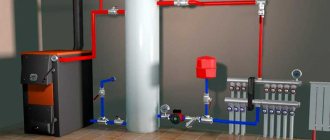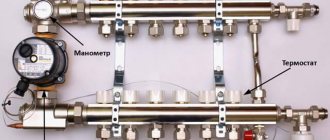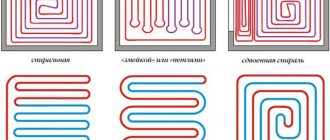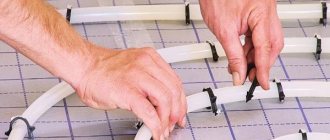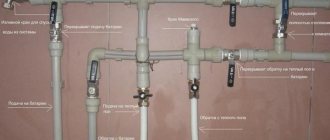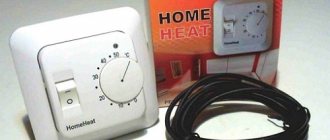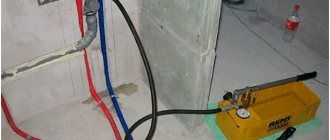Is it possible to connect a heated floor to a boiler or not?
When constructing water-heating floors, owners of apartments or private houses should:
- make a structure that will warm the air in the room to the required level;
- choose a profitable option in terms of installation and operation, which will be inexpensive.
First, we suggest that you learn the structure and operating principle of a water heated floor and the possibilities of combining the system with various devices (radiators, three- and two-way valves, etc.)
Gas or electric boilers are used to heat the coolant. More often, gas-fired boilers are installed in private buildings. It will not be possible to install such equipment in apartments with central heating.
In addition, to connect to a common heating system, you must obtain special permission. Therefore, there is a need to find an alternative method - this is the installation of an electric boiler.
Boiler is a device for heating water from electricity for domestic purposes. But it is worth noting that it was not originally intended to heat liquid for underfloor heating. Therefore, this will be an additional load for him, as a result of which the water heater may fail.
However, it is still possible to power the floor from a boiler, but it will not be possible to heat large areas using this method. This option is ideal only for the bathroom or toilet.
For your information! Correctly calculating the load on the electric heater is important.
Types of boilers
A water heater is an electric boiler equipped with a tank in which heated liquid accumulates. For domestic purposes, designs up to 100 liters are used, and for industrial purposes up to 300 liters. An industrial type is recommended for installing floor heating.
By design, boilers are either instantaneous or storage.
Flow-through
Flow-through - a compact tank with a square-shaped ten, which is connected to a cold water supply. When turned on, the water heats up almost immediately. The power of such heaters is 6 - 10 kW, so they place a large load on the electrical network.
A tankless water heater is not suitable for heated floors.
Cumulative
A storage heater is a container with two casings, between which there is a protective layer of heat-insulating material (polyurethane foam). The outside body is enameled steel.
The inside of the flask has a coating of glass enamel; the process of its application is spraying, which allows you to obtain a smooth surface on which scale does not form. In addition, the enamel does not react to salts present in water and is not subject to corrosion.
Some models have an internal coating not of glass enamel, but of glass porcelain - the surface is of high quality, but if it is exposed to high temperatures for a long time, cracks can form. However, manufacturers guarantee that the device will operate uninterruptedly for at least 10 years.
Another type of coating that is used for boilers is stainless steel with titanium, which can withstand high temperatures. A water heater with such a coating will last for many years.
A heating element (in the form of a tubular heater) is placed inside the container; it heats the coolant. The ten is placed in a metal pipe, this protects it from scale. In addition, the flask contains a magnetic anode - a rod with positively charged particles that neutralize the negative charge.
This helps reduce corrosion formations. The rod needs periodic replacement, as it wears out quite quickly. The water heater is equipped with pipes through which cold water flows in and hot water comes out.
For your information! Today, models of electric water heaters with a volume of 250 - 300 liters have appeared on the market, which were specially designed for use in heating systems. Their difference is in the location and cross-sectional size of the supply and return openings.
The standard power of storage models is 1.5 - 3 kW. The device is similar to a thermos; the water is heated and then slowly cooled, thereby maintaining a high temperature for a long time.
In addition, these types have a thermostat, which allows you to set the heating temperature required for heated floors. And when the required temperature level is reached, the boiler automatically turns off, which contributes to rational energy consumption.
In shape, boilers can be horizontal or vertical. The vertical design is recommended for arranging heating floors.
It is important to know! To heat 15 liters of water to 60 degrees, you will need a heater with a power of 1 kW, heating time is 1 hour. A 100 liter tank will reach this level in 3 hours, with a power of 3 kW.
Electric water heaters. Design Features
A heating system based on electric water heating is not anything special. A boiler is a device in which water is heated using electricity. According to the principle of operation, boilers are divided into two types:
For models with a storage tank, the main design element is the heating element, which provides water heating. Heating elements are usually installed in a storage tank, which receives tap water. The mode of turning the heating elements on and off is provided automatically.
Note: From a technological point of view, a storage boiler is more like a thermos. The water is heated in the inner casing. The outer casing of the device performs protective functions, protecting the internal tank from mechanical damage and reducing the amount of heat loss. The space between the housings is filled with insulating material (mineral wool or expanded polystyrene).
During normal operation of the device, depending on the power of the heating elements and the volume of the tank, water is heated within 2-3 hours. Due to the double casing, the water in the boiler maintains the set temperature for a long time (12-24 hours). The diagram shows the internal structure of a storage boiler, which is connected to an autonomous underfloor heating system.
READ How to connect Beeline SMS notifications
Due to its high performance parameters, the storage boiler by its design is best suited for ensuring the operation of heated floors in your apartment.
If we talk about a flow-type electric boiler, then the concept is completely different. There is no storage tank, and the entire process takes place inside a compact flask, which is equipped with a heating element. Unlike storage devices, instantaneous boilers are equipped with heating elements of higher power (6-20 kW), capable of providing intense heating of the water flow in a short period of time.
Important! The water in the instantaneous heater is heated to the required temperature in a matter of minutes (30-120 seconds), so the load on the home electrical network rapidly increases.
Operating principle of a water heater
The operating principle of an electric boiler is mixing cold and hot coolant. Heated water rises to the top, and cold water is located below, where it is heated.
The operating process of the water heater is as follows:
- The storage tank is filled with water through a special pipe. The inlet is equipped with a safety valve; it holds the liquid and does not allow it to flow back.
- The thermostat sets the required temperature, but not more than 80 degrees.
- The heater turns on automatically and water heating begins.
- The hot liquid rises upward and exits through the intake tube located on top of the tank.
- The coolant moves through the intake pipe into the floor pipeline.
Which boiler to choose?
For the construction of warm water floors, the model of a flow-through electric boiler is practically not suitable. The main disadvantage is the significant energy consumption.
The only suitable option for heated floors is a storage water heater. When choosing the type of heater, attention should be paid to the power of the equipment; this determines how intensively and quickly the coolant is heated, as well as its volume.
For your information! Devices with a power of 6 - 10 kW are specially designed for installation in conjunction with heating systems. Their main disadvantage is their high electricity consumption.
When calculating the power of an electrical appliance, you should start from the fact that to heat an area of 10 square meters you need a water heater with a power of 1 kW, so a household boiler model is not suitable for heated floors. It can only be used for small rooms - a bath or toilet.
The second point that you need to pay attention to when purchasing is the volume of the tank. The greater the amount of hot coolant received, the less often the water heater will be turned on periodically, in order to help save resources.
Which electric boiler to choose for underfloor heating
It is worth noting that there are no boilers that are specially produced for connecting “warm floors”. Some models, of course, have this function and they have the ability to work in this mode.
Photo source: olx.ua
When choosing a boiler for a heated floor system, you must focus on the following criteria:
- regulation of heating of the coolant and floors;
- equipment power;
- what type of heater is used;
- is the unit compatible with the “warm floor” system;
- the equipment must be highly efficient, easy to install, operate, maintain and repair;
- the unit must have safety systems and protection against corrosion of heating elements;
- what the body is made of (it is better to choose stainless steel);
- whose production;
- correspondence of working volume and power.
Each region has its own profitable fuel. For some, it is more economical to heat using gas, a stove, or central heating, while others use electricity. One of the best options is floor heating using an electric boiler.
This equipment can be connected to the “warm floor” system directly in rooms with a small area, and for a house with a large number of rooms, special distribution units are purchased.
One of the main requirements when choosing a unit is the ability to provide the floor heating system with coolant. This function allows you to set the desired temperature, which should have the following parameters: the supply temperature should be +35-45°C, and the return temperature should be approximately +25°C. When placing an electric boiler close to a living space to use less water, it is better to opt for imported equipment, and additionally install a thermostat and programmer.
If floor heating is an additional heating circuit, then it is recommended to choose an option that does not have a pump. If a water heated floor is used as the main source, then the optimal choice is a separate small boiler; it will ensure autonomous operation of the floor heating system. However, in this case, it is necessary to equip a mixing unit - a system where water will be prepared for floor heating. When the boiler heats the house with the help of radiators and the floor heating system also comes from it, then the choice of equipment is quite simple. But if the rooms are not heated using a boiler, then you should choose a model that has the ability to set a low floor heating temperature.
There are several types of heater in electric boilers:
- heating elements;
- induction (high efficiency, low energy consumption unlike heating elements);
- water (used for autonomous heating of apartment buildings).
Features of the design of a heated floor connected to a boiler
When designing a floor heating system from a boiler, you need to take into account:
- the size of the pipeline and the number of branches, the longer the circuit, the slower the fluid circulation will be;
- power of the heating element - if the size of the lower threshold of the heated room corresponds to the power of the boiler, then after some time the efficiency of heating the coolant may decrease; the solution is to buy a heater with a power reserve of 20%.
In addition, the system requires constant maintenance - periodic descaling of the storage tank and heater. This procedure will help keep underfloor heating pipes in good condition and increase their service life.
It is recommended to connect the boiler in a bathtub or room located close to the heated room.
And to increase the productivity of the device, the structure must be equipped with a circulation pump.
By observing all of the above points, you can build a hydrofloor that can provide heating for your apartment.
Design features of underfloor heating based on an electric boiler
When designing your own heating system, the following are taken into account:
Compliance with all of the above factors will allow you to proceed directly to the installation of the underfloor heating heating system, then connecting it to the boiler. Installation of a boiler is usually done in the bathroom or next to the room that will be heated. To increase the performance of your heating system, you can install a circulation pump. Thanks to this device, you can achieve an uninterrupted supply of coolant to the water circuit.
Important! It is better to entrust the connection of the circulation pump to specialists who have an understanding of the operation of this device.
Connection diagrams for heated floors and boilers
There are several schemes for connecting a heated floor to an indirect water heater. Let's look at the simplest ones:
- Using a three-way valve - the essence lies in the interaction of two circuits: a warm floor and a water heater. This valve distributes the coolant between them. It is controlled automatically using a thermostat on the heater. This system promotes rapid heating of water in the boiler, while it is possible to completely shut off the supply of hot water to the floor branches. And when the set temperature is reached, the valve is activated and the supply is resumed. This piping method is suitable for constant use of the boiler.
- With two forced circulation pumps - this option is recommended for intermittent, seasonal use of the device. One is placed on the supply pipe in front of the water heater, and the other on the floor contour.
A thermal relay is used to power the circulation pump, so it functions only when the temperature drops below normal. Heating accelerates, and forced circulation is turned on. In this scheme there is no three-way valve, and the connection is made using tees.
- Using a hydraulic arrow - this method is recommended for boilers with a volume of 200 liters or more, and with several heating branches. A system with a hydraulic distributor makes the circuit simpler, and there is no need to install pumps on each floor circuit. The hydraulic arrow ensures equal coolant pressure in all loops. However, it is difficult to make a harness with your own hands in this way without experience.
Construction and connection of heated floors to the boiler
For clarity, let’s look at how to make a heated floor from a water heater, using the example of using a 3 kW heater to heat an area of 30 m2, with the installation of a three-way valve.
We will need a recirculating boiler with outlets to connect hoses for hot and cold water supply. The recommended diameter of the pipes is 2.6 centimeters. In addition, you should stock up on the tools that you will need in your work so as not to be distracted during the installation process.
The sequence of construction of hydrofloors from a water heater is as follows:
- Preparing the rough base - it should be leveled and cleared of debris.
- Installation of the collector unit - it must be mounted on the wall, or mounted in a specially equipped metal box.
- Taping damper tape around the perimeter of the room will help maintain the integrity of the concrete screed.
- Hydro and thermal insulation - polyethylene film can be used as a waterproofing material. The choice of thermal insulation material is huge, from ordinary polystyrene foam to polystyrene foam mats with bosses.
- Installation of the water circuit - these can be pipes made of copper, polyethylene or heat-resistant plastic. The heating elements are laid according to the planned pattern and with a set step. The pipes can be attached to the reinforcing mesh, which is laid on the thermal insulation, with plastic clamps, or fixed between the grooves of polystyrene plates.
- Connect the circuit to the distribution manifold - one end to the cold tap, and the other to the hot one.
- The boiler is connected to the distribution unit using metal pipes.
- Installation of a three-way valve with a thermal head on the manifold - to regulate the temperature level of a warm water floor.
- Connecting a circulation pump to a warm floor - it provides the flow and necessary pressure of water in the floor pipeline.
- Installation of an expansion tank - it is necessary to remove excess water from the heating system. It should be mounted on a cold metal pipe near the outlet to the boiler. And in front of it you need to equip a tube for air outlet.
- Checking the system for operability - to identify possible leaks and malfunctions. Pressure testing is carried out during the day under operating pressure.
- Filling the screed - the contour of the floor is poured with concrete mortar. The procedure is done when there is pressure in the pipes. The concrete layer must be allowed to dry thoroughly, this will take about a month.
- Laying the finishing coating - it is laid only on a completely dry concrete base.
You can turn on the water system only when the screed, as well as the tile adhesive if ceramic tiles were used as a floor covering, have dried. The temperature should be raised to operating condition gradually over several days.
The principle of operation of this circuit is to heat water in the tank, then it is discharged through the collector into the floor circuit. The waste coolant is returned through the distribution unit to the return pipeline.
If the water temperature exceeds the required level, the three-way valve automatically shuts off the hot water supply and opens the cold water supply. The mixing process is carried out in a special chamber. When the coolant reaches the desired degree of heating, the thermal head closes the flow of cold water.
The heater and collector are equipped with separate automatic devices for temperature regulation. The device on the collector is responsible for the coolant in the floor line, and on the shade - for the level of water heating.
You can install a heated floor from a boiler both in a house and in an apartment. Installation is not difficult, the main thing is to follow the technological process and instructions. In addition, the low cost of installation is of no small importance, because a water heater costs less than an electric boiler.
However, it should be noted that the operation of such a heating system is accompanied by high energy consumption. Therefore, it’s up to you to decide how to heat your home - with a regular radiator or underfloor heating from a boiler.
Selecting an indirect heating boiler
Before purchasing and connecting a buffer tank-accumulator (as BKN is also called), you should understand the design features of the most popular types. The fact is that there are many types of equipment, including combined models that operate from heating systems and alternative energy sources simultaneously.
We will look at traditional coil boilers that use hot water as a heater.
Design features and operating principle
What does indirect heating mean? Directly heated devices operate by connecting to electricity or a gas burner; BKN has a different heat source. The water is heated by connecting to the hot water supply, that is, it turns out that the source is the coolant - hot water (or its substitute).
If we look at new models of well-known brands, we will notice that gas boilers and KN boilers often have the same design. They are mounted side by side or one under the other - this way you can save on the placement area.
The main element that performs the heating function is a steel or brass heat exchanger (coil) with a large surface area, which is located inside a metal tank coated with a protective layer of enamel. To prevent the water from cooling too quickly, the outer side of the housing is surrounded by a layer of thermal insulation, and some models are surrounded by a casing.
An important part that most heating devices are now equipped with is a magnesium anode. A rod fixed to the top of the device protects metal parts from corrosion, as a result the water heater lasts much longer.
Barriers against high pressure are a safety valve and a built-in thermostat. If the tank is not equipped with a safety group, it is installed separately when installing the piping.
Often the water circulating in the heating system does not exceed 65-70 °C. Many people doubt its effectiveness when it acts as a heat source for heating in a BKN. In fact, the indicated temperature is sufficient, because the speed and magnitude of heat transfer largely depends on the area (quite large) of contact of the coil with water.
How does the heating process occur? Cold water intended for heating enters through a separate hole and fills the entire container. Water also flows from the boiler into the heat exchanger, but already heated. The hot walls of the coil transfer heat to cold water, which at the outlet already has a temperature suitable for taking a shower or washing dishes.
Advantages of controlled equipment
Controllability is a characteristic that affects the assembly of the entire water heating system. There are two types of BKN: simple (cheaper) and with a built-in control function.
A distinctive feature of controlled models is the additional equipment with a temperature sensor and the ability to supply/stop the supply of water to the heat exchanger. Such equipment operates automatically.
To start you need to connect:
- inlet/outlet for hot water from DHW;
- supply of cold water to the tank;
- manifold for distributing heated liquid at the outlet.
After this, you can start the boiler - the water will begin to heat up.
The process of connecting and piping an indirect heating boiler occurs in one of the following ways (described below).
How can control affect water temperature? Almost nothing. The maximum value that the outlet temperature can reach does not exceed the parameters of the coolant in the DHW system. Most likely, it will be 1-2 °C lower.
If more intense heating is required (this can happen if the boiler usually operates in low temperature mode), then it is better to choose a model with a built-in heating element.
It is advisable to purchase such equipment together with boilers operating on solid fuel (the water remains hot even after the boiler has cooled).
Types of devices with additional functions
Tanks with a simple design are only part of the range presented on the water heating equipment market. There are many models of boilers, the functions of which are very useful for integration into a DHW system.
For example, one of the purposes of more expensive models is heat accumulation. If power outages are possible or daily consumer tariffs are too high, the accumulation mode will be very useful. The design features of such models are enhanced thermal insulation and increased tank volume (300 liters or more).
Another option that provides the fastest supply of hot water to water collection points is a recirculation boiler. Unlike the usual design, this one is equipped with three pipes for communication with the hot water supply system. Two supply hot water, one supply cold water. Water is supplied using a pump.
When using a model with recirculation, you can install an additional useful circuit, for example, for installing a heated towel rail.
The water in such a tank heats up faster than in units with a heat exchanger, but its cost is higher.
Tank size and its meaning
Cylindrical and cubic tanks differ in their sizes. Their volume is indicated in liters: there are small models with a capacity of 80-100 liters, but there are also bulky ones that can hold up to 1400-1500 liters. The size is selected based on the family’s need for hot water.
Dimensions are important during installation. Only light models are suitable for wall installation - up to 200 liters; all others are floor-mounted. Both horizontal and vertical wall-mounted devices have special fastenings, while floor-mounted ones are equipped with legs or a small stand.
Rectangular units take up slightly less space than cylindrical units due to their tight fit to the pipes.


